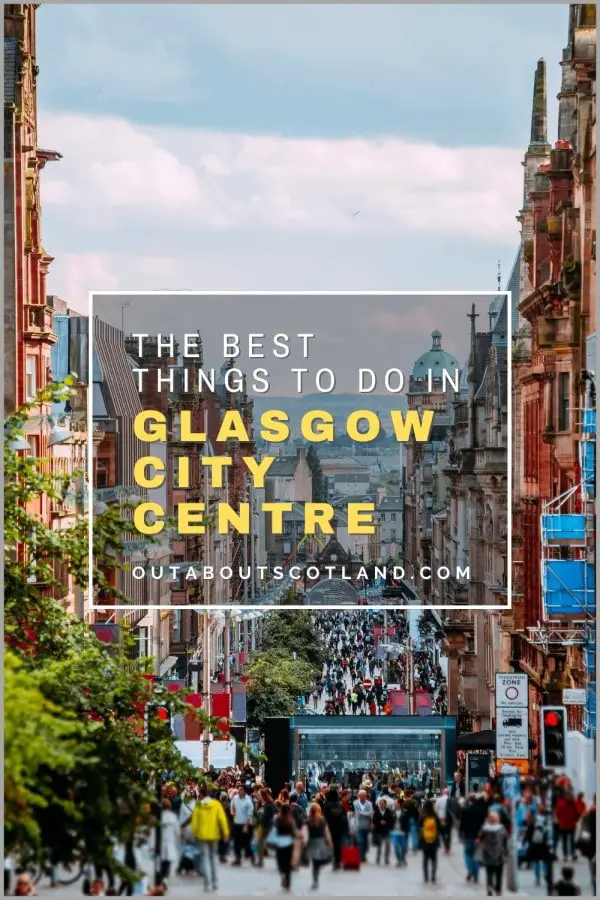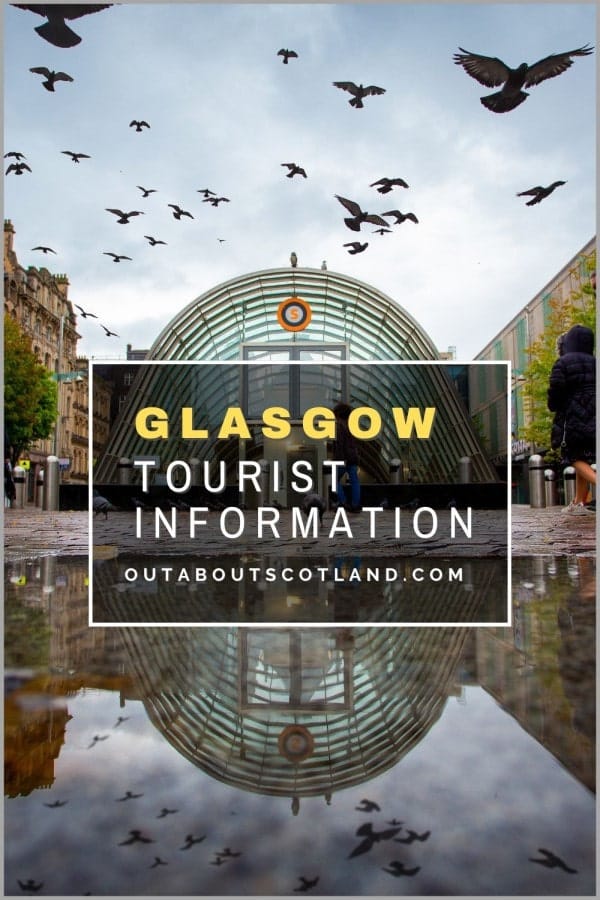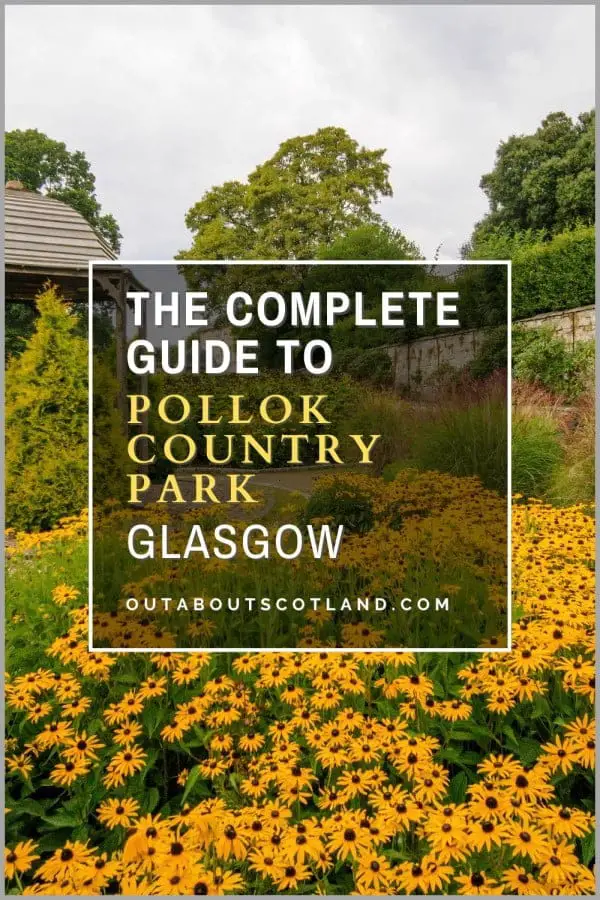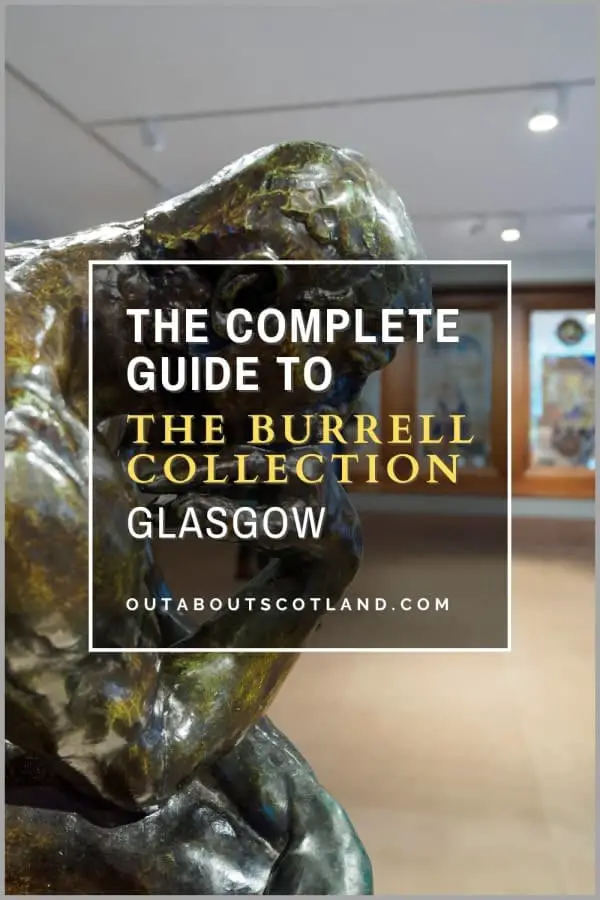Glasgow is a vibrant and exciting city that offers a wealth of activities and attractions for visitors of all ages. Whether you’re interested in history, architecture, music, or food, you’ll find plenty of things to see and do in this dynamic Scottish metropolis.
However, one thing that many first-time visitors fail to realise is just how big Glasgow actually is. While there are great bus and subway systems to get tourists around, deciding where to go for a day trip may be difficult, particularly with so many tourist attractions on offer.
To make things a little simpler, we’ll look at some of the best things to do in Glasgow’s city centre that are all readily walkable. The following list includes the city’s must-see landmarks, museums, and art galleries, most of which are within a 30-minute stroll of Glasgow Queen Street train station.
Whether you’re planning a trip to Glasgow or are simply curious about what the city has to offer, read on to discover some of the best things to do in Glasgow city centre.
Glasgow City Centre Tours
Protect Your Family From Scotland's Biting Midges
- Powerful, reliable protection for up to 8 hours
- Water- and sweat resistant
- Repels midges, mosquitoes, horse flies, sand flies, fleas and ticks
- Safe for use on adults, children over 30 months and pregnant women
- Non-sticky, moisturising with a pleasant fragrance
- Packaging may vary
Kelvingrove Art Gallery and Museum
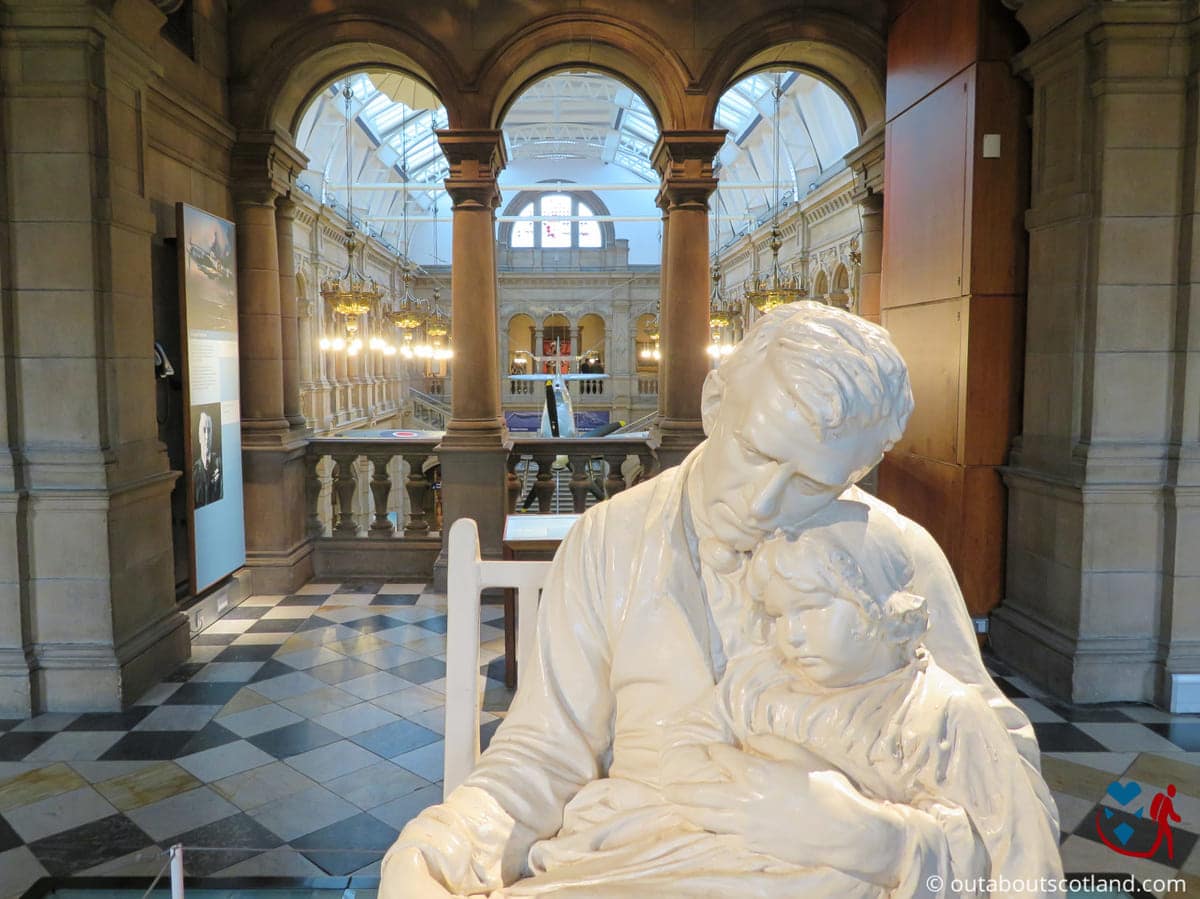
Out About Scotland Guide: Kelvingrove Art Gallery and Museum
| Address: | Argyle Street, Glasgow, G3 8AG |
| Opening Hours: | Monday - Thursday and Saturday: 10 am-5 pm Friday and Sunday: 11 am-5 pm |
| Admission Price: | Free Temporary paid exhibitions |
| Parking: | Paid car park on-site Free parking for blue badge holders |
| Contact: | 0141 276 9599 museums@glasgowlife.org.uk |
| Facilities: | Toilets, disabled access, hearing loop, baby changing, cafe, restaurant, shop, cloakroom, |
| Photos: | Virtual Tour YouTube Video |
Kelvingrove Art Gallery and Museum is the main attraction in Glasgow’s beautiful Kelvingrove Park, an 84-acre green space that was built for recreation in 1852. This museum and art gallery has exhibits that change throughout the year and cover a wide range of topics such as modern art, animals, ancient Egypt, and the history of Scotland.
The French and Dutch art galleries, in particular, are noted for holding works of international importance, which is just one of the reasons why the attraction is one of Scotland’s most popular tourist destinations. During your visit, you’ll see numerous galleries devoted to the work of major Scottish artists, as well as galleries devoted to The Glasgow Boys and renowned Glaswegian architect Charles Rennie Mackintosh.
Like another beloved Glasgow institution – The Hunterian – the level of detail in Kelvingrove is astounding, but Kelvingrove is far larger and has a greater variety of things to see including the photo-worthy Floating Heads art installation in the East Court and the restored RAF Spitfire in the West Court.
If you’re searching for a fun place to spend the day by yourself, with a partner, or with the kids, Kelvingrove is a fantastic option. And the best part is that it’s free, just like all the other great museums in Glasgow.
The Riverside Museum of Transport
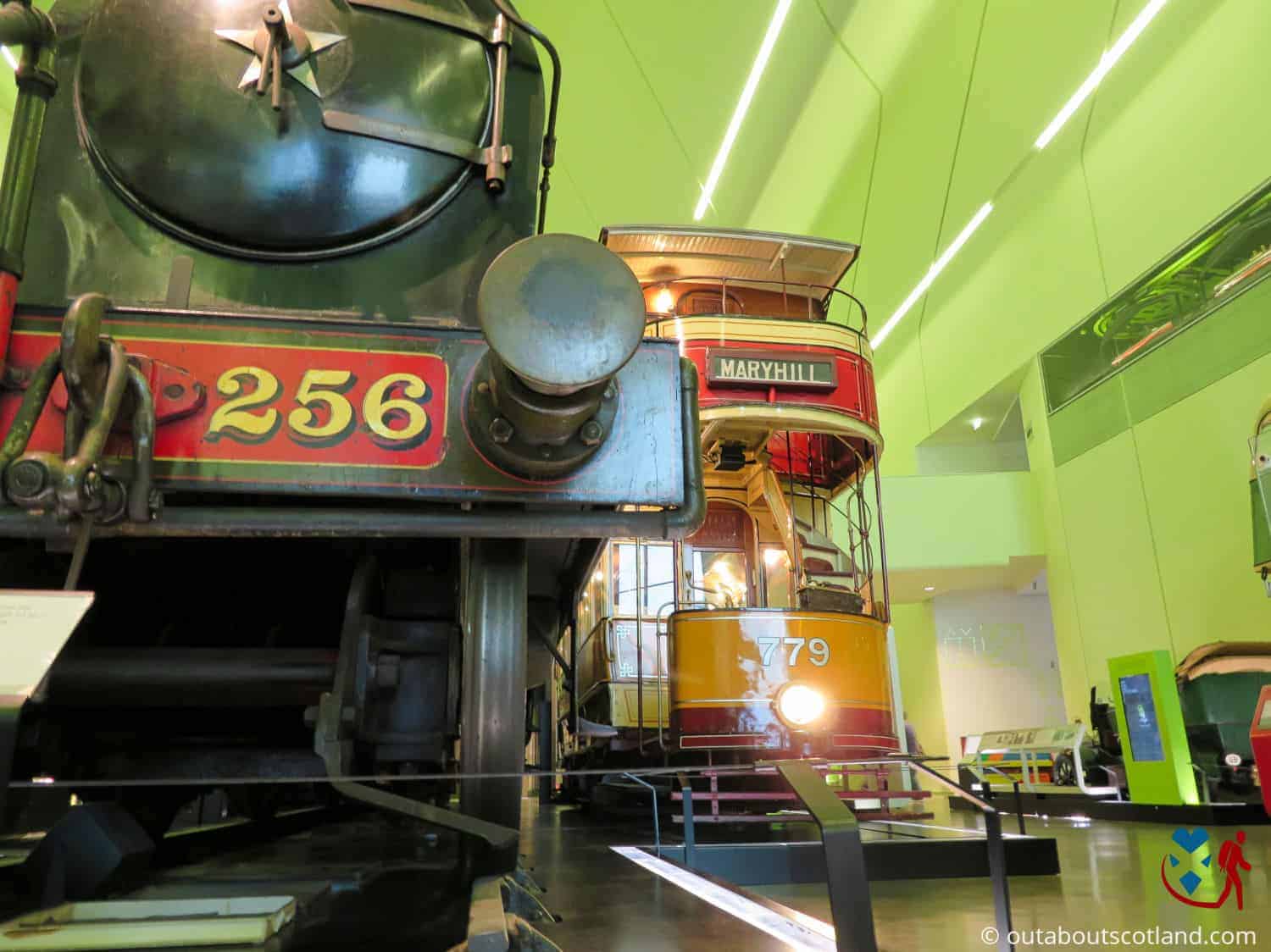
Out About Scotland Guide: The Riverside Museum
| Address: | 100 Pointhouse Road, Partick, Glasgow, G3 8RS |
| Opening Hours: | Monday-Thursday, Saturday: 10 am-5 pm Friday and Sunday: 11 am-5 pm |
| Admission Price: | Free |
| Parking: | On-site car park |
| Contact: | 0141 287 2720 museums@glasgowlife.org.uk |
| Facilities: | Shop, restaurant, toilets, wheelchair access, hearing loop, baby changing, cloakroom |
| Photos: | YouTube Video |
Glasgow is a must-see for anyone touring Scotland because it has so many great tourist attractions, many of which are located close to the city centre. The Riverside Museum at Pointhouse Place on the River Clyde is one such attraction that eclipses most others in size.
Since some of the largest shipbuilding companies in the world previously called the River Clyde home, it’s only fitting that the Riverside Museum is devoted to transport of every kind, from roller skates to bicycles, mopeds to cars, trains to trams, and ships big and small.
The Transport Museum showcases more than just exotic vehicles, though, and you can also get up close to many commonplace forms of transport that are sure to make you smile, such as the humble Ford Cortina and Raleigh Chopper, both of which now have a cult following.
Additionally, there are a tonne of interesting exhibits that you can interact with to learn more about the history of transport in Scotland, but as you’d expect, a large portion of the museum is devoted to Glasgow’s transport history.
During your visit, you can learn more about the city’s connections to shipbuilding and even go back in time by walking through a replica of Glasgow’s streets. You’ll also get the chance to learn about some of the major inventions that revolutionised transportation, such as early automated factory machines.
Whether you’re a native Glaswegian or simply passing through, the Riverside Museum provides something for every age group and interest.
Stop Painful Blisters Spoiling Your Time In Scotland
- Deep cushioning to relieve pressure and prevent painful rubbing
- Hydrocolloid active gel technology creates an optimal healing environment for foot blisters
- Adhesive, tapered edges so Compeed flexes with movement and won't rub off
- Keeps natural moisture in and germs out, with translucent edges to help blend in with the skin
- It prevent, ease the pain, and make a recovery faster
Glasgow Science Centre
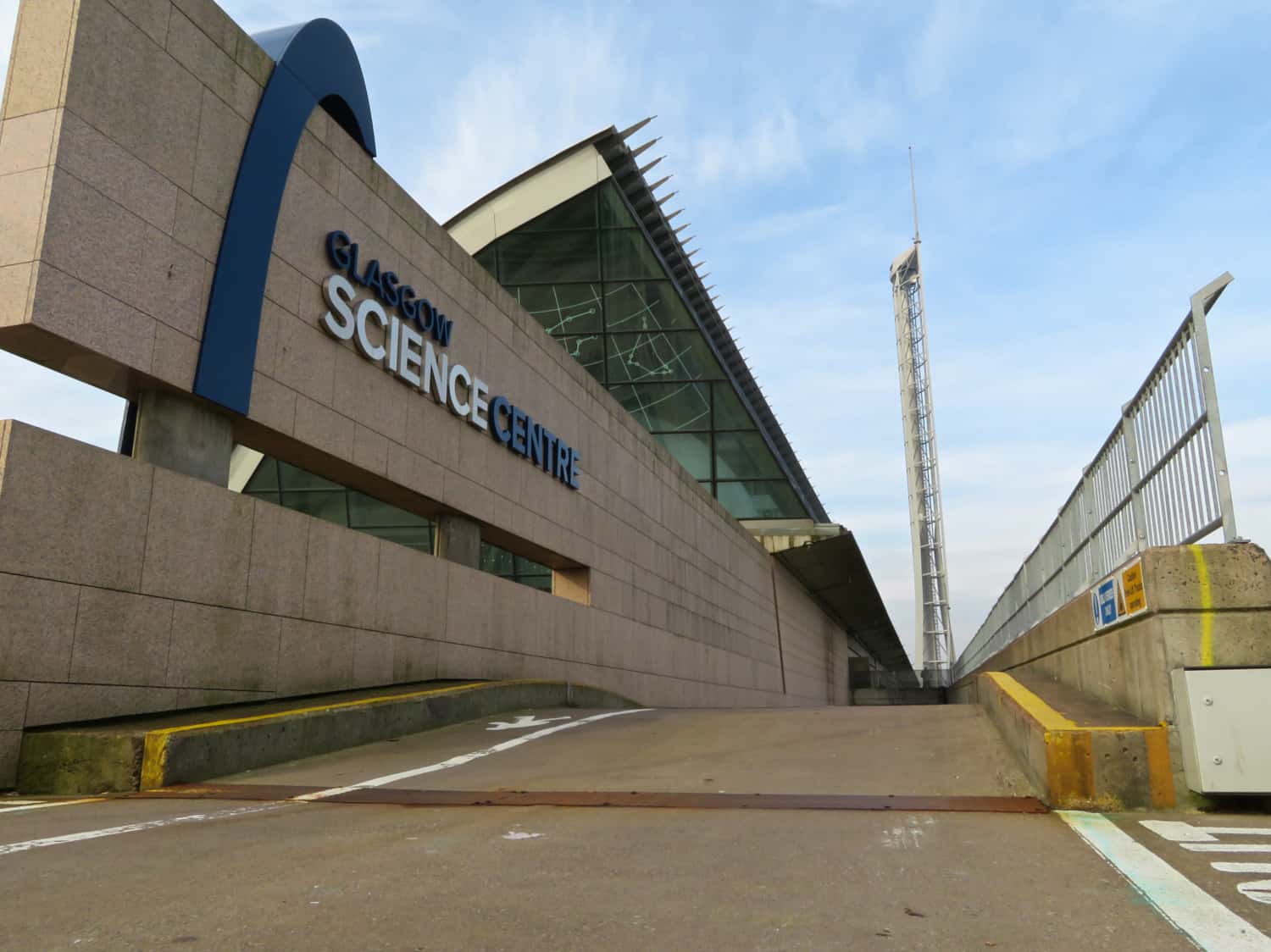
Out About Scotland Guide: Glasgow Science Centre
| Address: | 50 Pacific Quay, Glasgow, G51 1EA |
| Opening Hours: | Monday to Sunday 10.00 to 17.00 |
| Admission Price: | £12.50 per adult £10.50 per child Under 3's go free but require an under 3's ticket |
| Parking: | Car park on-site. £3 per day. £1 per day for Science Passport holders. |
| Contact: | 0141 420 5000 contact.us@gsc.org.uk |
| Facilities: | Gift shop, restaurant, toilets, wheelchair access, baby changing area, disabled parking |
| Photos: | YouTube Video |
The Glasgow Science Centre is an exceptionally popular tourist attraction, situated in the middle of the city on the banks of the River Clyde, not far from the Scottish Exhibition and Conference Centre (SECC). This outstanding venue is jam-packed with entertaining and instructive displays that educate visitors of all ages about the fascinating world of science and technology.
The GSC is divided into three major areas: the Science Mall, the Glasgow Tower, and the IMAX, each of which is a worthwhile attraction in its own right.
The Glasgow Tower is located behind the distinctive domed IMAX theatre, although most of the exhibits are in the crescent-shaped Science Mall which resembles a ship lying on its side; the reason being that it’s positioned next to a canting basin where ships used to be turned onto their sides for hull cleaning.
You can purchase separate tickets for the planetarium and IMAX or a single admission ticket for the science mall, but I recommend paying extra for a Glasgow Science Centre passport which permits unrestricted re-entry to all areas for 12 months.
There’s a handy on-site car park, and once inside, you can buy food, drinks, and souvenirs, allowing you to spend a full day at the site.
Glasgow Gallery of Modern Art
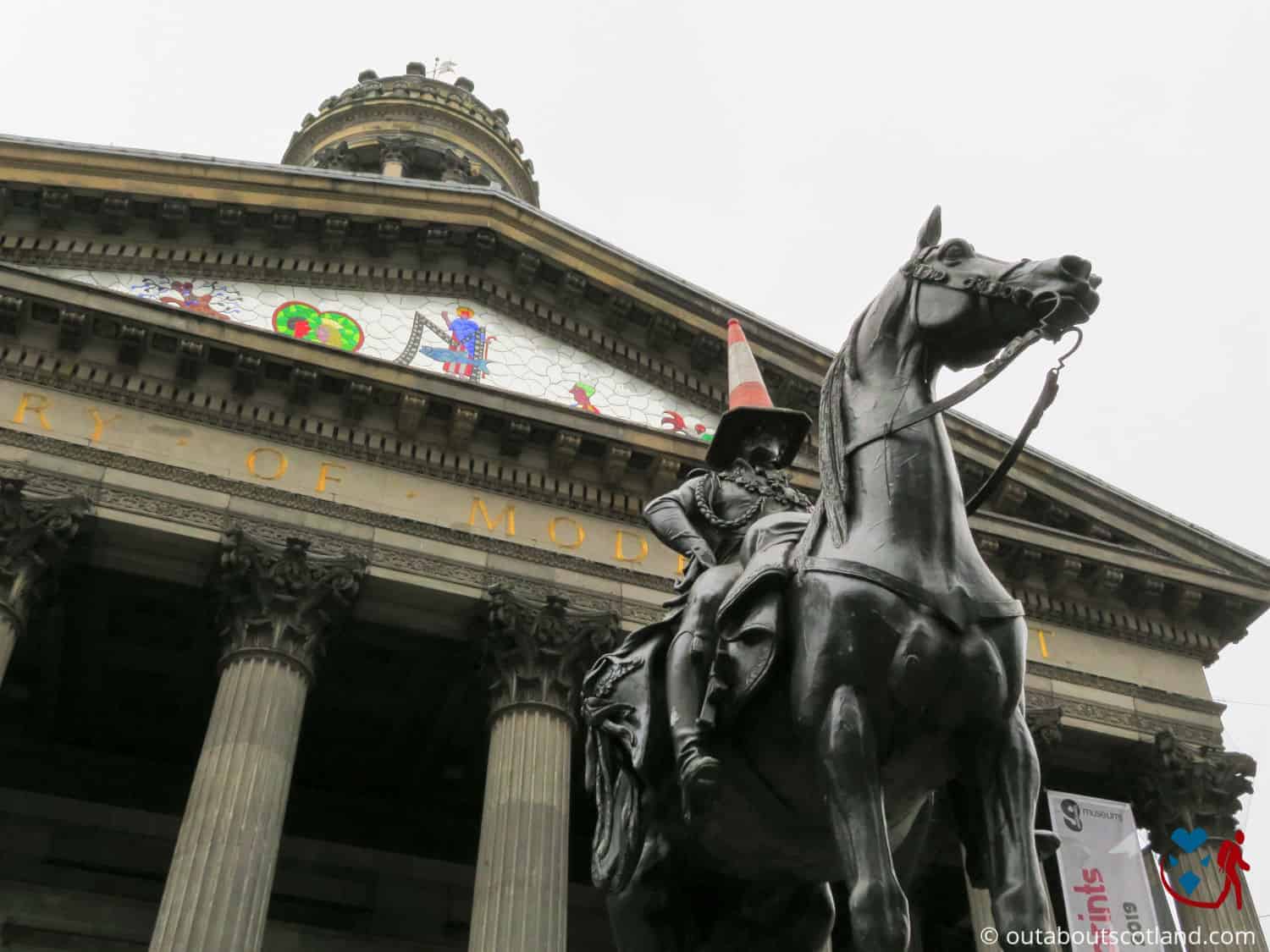
Out About Scotland Guide: Glasgow Gallery of Modern Art
| Address: | 111 Queen Street, Royal Exchange Square, Glasgow, G1 3AH |
| Opening Hours: | Monday-Thursday, Saturday: 10 am-5 pm Friday and Sunday: 11 am-5 pm |
| Admission Price: | Free |
| Parking: | None |
| Contact: | 0141 287 3050 museums@glasgowlife.org.uk |
| Facilities: | Cafe, shop, toilets, disabled access, baby changing, cloakroom |
| Photos: | YouTube Video |
The Glasgow Gallery of Modern Art, also known as the GOMA, is highly recommended for both art enthusiasts and those with a passing interest in the topic, and it has to be one of the major highlights of the city centre.
The gallery is free to visit, which is pretty amazing since it features some of Scotland’s most important works of art as well as masterpieces on loan from collections around the world.
Since it opened in 1996, millions of art lovers have come to the GOMA to see the works of Andy Warhol, Margaret Tait, David Hockney, and many others in a wide range of themed exhibitions. The majority of these exhibitions are permanent, while some have a rotating selection of artworks, in addition to temporary exhibitions that usually have an entrance fee.
The GOMA is more than just a gallery though; it’s also an educational resource for students and the general public. Anyone interested in doing so can enrol in ongoing art classes and workshops, and there are even classes for children so the whole family can enjoy art together.
Whether you are a modern art enthusiast or not, the Glasgow Gallery of Modern Art is easily one of the best free places to visit in the city.
Protect Your Family From Scotland's Biting Midges
- Powerful, reliable protection for up to 8 hours
- Water- and sweat resistant
- Repels midges, mosquitoes, horse flies, sand flies, fleas and ticks
- Safe for use on adults, children over 30 months and pregnant women
- Non-sticky, moisturising with a pleasant fragrance
- Packaging may vary
Glasgow Cathedral
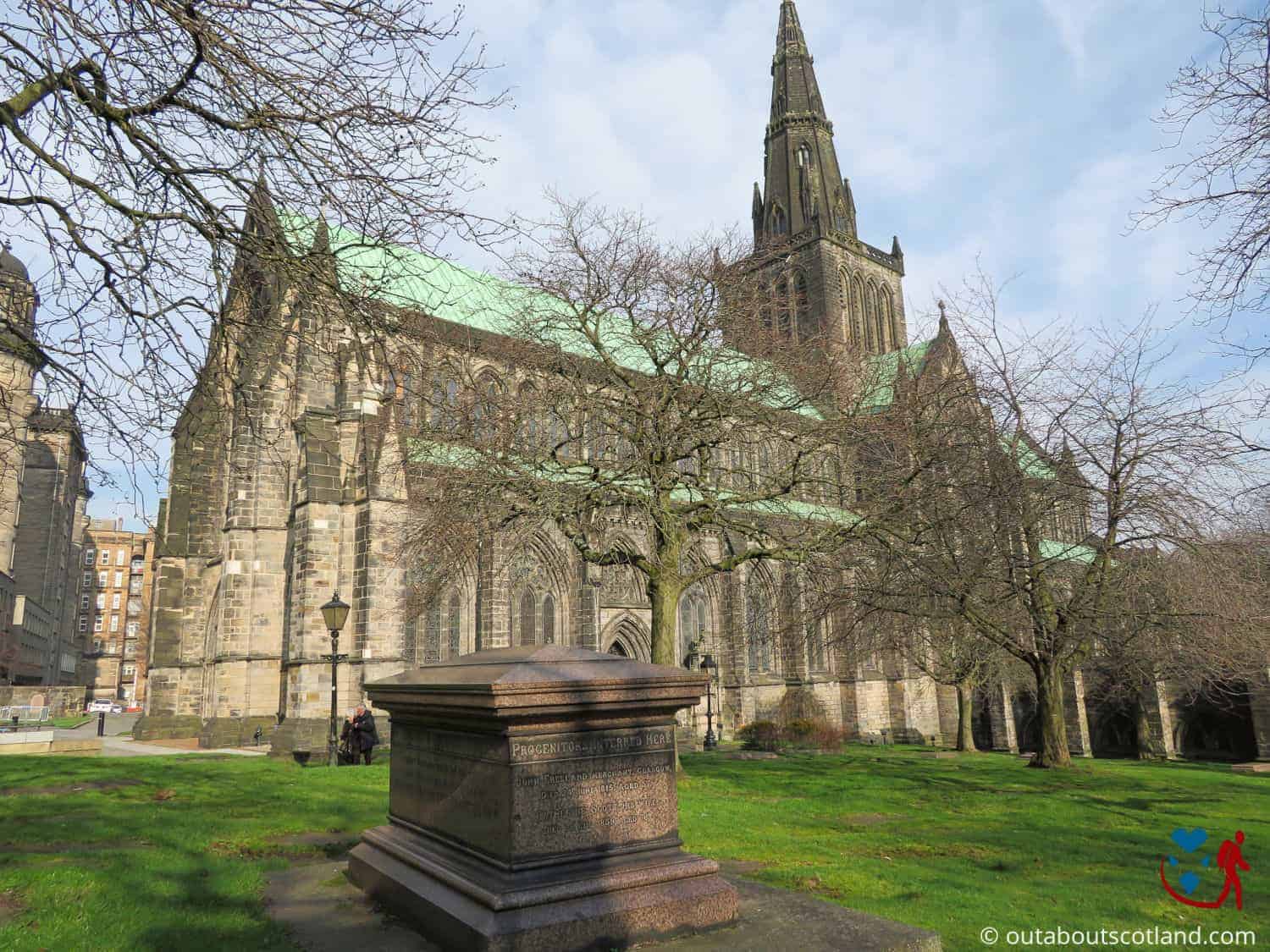
Out About Scotland Guide: Glasgow Cathedral
| Address: | Castle Street, Glasgow, G4 0QZ |
| Opening Hours: | 1 Apr to 30 Sept: Mon to Sat, 10 am to 5 pm Sun, 1 pm to 5 pm Last entry 4.30 pm 1 Oct to 31 Mar: Mon to Sat, 10 am to 4 pm Sun, 1 pm to 5 pm Last entry 4:30 pm Closed for lunch 12 noon to 1 pm |
| Admission Price: | Free |
| Parking: | Paid car park on Castle Street |
| Contact: | 0141 276 1614 |
| Facilities: | Shop, disabled access. Toilets at the St. Mungo museum. |
| Photos: | Virtual Tour YouTube Video |
Many people consider Glasgow Cathedral as one of the best free things to do in the city because it’s close to both the Glasgow Necropolis and the St. Mungo Museum of Religious Life and Art.
The mediaeval cathedral was constructed in the 1100s in honour of St. Kentigern, also known as St. Mungo, and is one of the most complete mediaeval buildings in Scotland, surviving over 900 years of religious upheavals and wars.
Even now, the cathedral’s dramatic Gothic architecture and ornate stone carvings amaze, just as they no doubt did when it was first constructed. The exterior may entice you to whip out your camera, but it’s the interior that will make you snap away in a frenzy.
Glasgow Cathedral is one of the few buildings I’ve visited that actually made me stop and stare upon entering – just picture a miniature York Minster to get the general idea.
The cathedral has many interesting areas to explore, including the crypt where St. Kentigern’s remains are kept, and Historic Environment Scotland has erected numerous displays to help visitors learn about the saint and the cathedral’s fascinating history.
The shrine of St. Kentigern on the lower level is well worth seeing, as is the nave with its stunning stained glass windows and the vividly painted stone bosses on the ceiling of the Blacader aisle.
As far as facilities go, there’s a small gift shop selling maps and souvenirs at the entrance, but there’s no cafe or toilets, which isn’t really a big deal as there’s a very good cafe with public conveniences in the St. Mungo Museum next door.
Glasgow Green & the People’s Palace
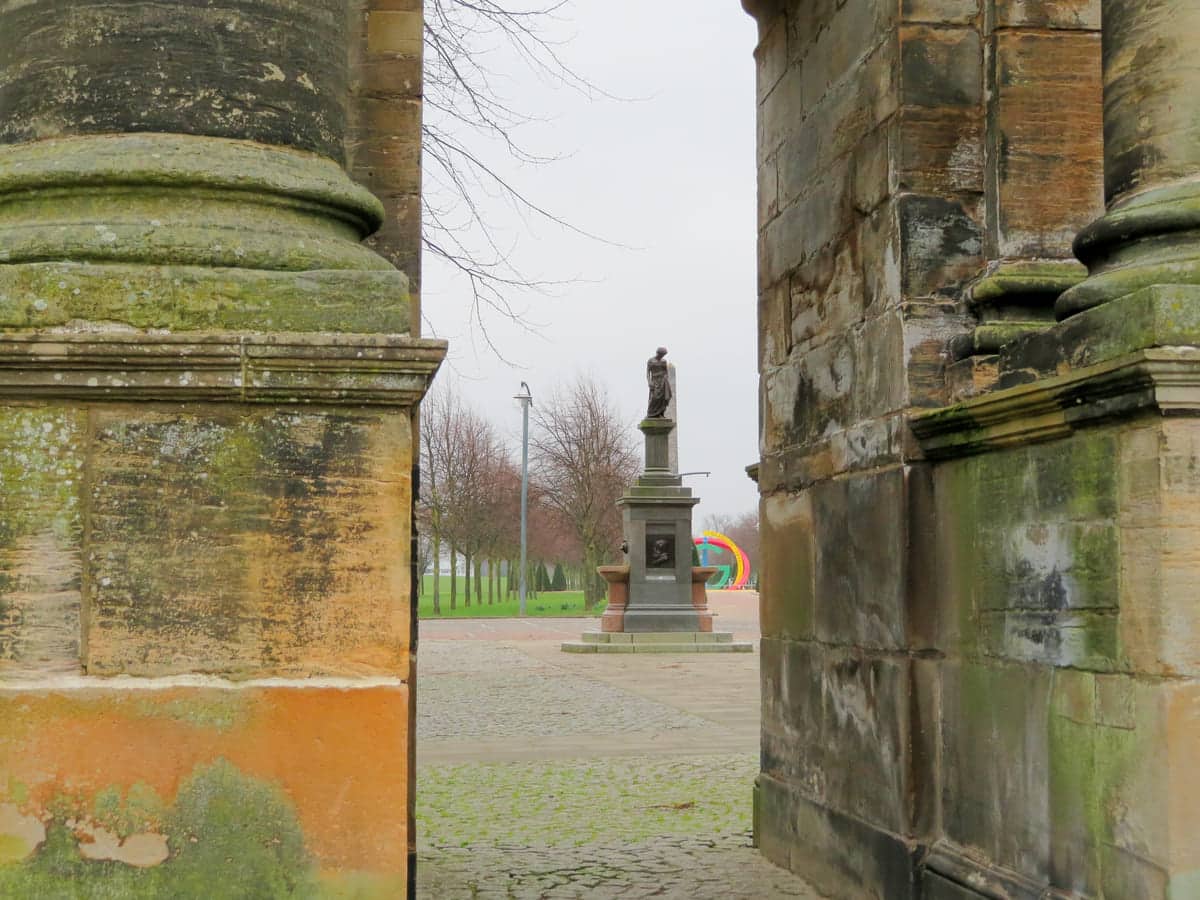
Out About Scotland Guide: Glasgow Green and The People’s Palace
| Address: | Templeton Street, Glasgow, G40 1AT |
| Opening Hours: | 24/7 |
| Admission Price: | Free |
| Parking: | No on-site parking |
| Contact: | 0141 287 5064 |
| Facilities: | Facilities in The People's Palace - Cafe, toilets, wheelchair access, hearing loop, baby change area |
| Photos: | Virtual Tour YouTube Video |
As Scotland’s biggest city, Glasgow is home to more than 90 parks and gardens, including Kelvingrove Park, Pollok Country Park, and Glasgow Green. King James II bestowed Glasgow Green, the city’s oldest park, on the citizens of Glasgow in 1450, and it has played an important cultural role in the city since that time.
As a tourist destination near the city centre, Glasgow Green takes some beating. The park’s 55 acres are filled with monuments and historic buildings, and there are enough things to see and do to keep a family engaged for a good chunk of the day.
There are a number of amenities in the park, including a children’s playground, a bandstand, and sports facilities like a bowling alley and football fields. Tarmac paths connect all of these features, making it simple for visitors of all abilities to access them.
The beautiful Doulton Fountain and the huge Nelson’s Monument can be found inside Glasgow Green as well as remnants of the 2014 Commonwealth Games, but the crowning glory is the People’s Palace, a social history museum and garden conservatory that opened in 1898.
The ‘palace’ houses exhibitions on Glasgow’s social history including the city’s industrial heritage, working-class culture, and the lives of regular people over the years, as well as a Victorian-style glasshouse which is a wonderful place to relax while viewing an enormous collection of cacti, palm trees, and tropical flowers.
In addition to its historical significance, Glasgow Green has become the site of some of the city’s most important contemporary events, such as the TRNSMT music festival and the World Pipe Band Championships. The park also has an orienteering course and observation platforms from which to enjoy views of the nearby River Clyde.
Stop Painful Blisters Spoiling Your Time In Scotland
- Deep cushioning to relieve pressure and prevent painful rubbing
- Hydrocolloid active gel technology creates an optimal healing environment for foot blisters
- Adhesive, tapered edges so Compeed flexes with movement and won't rub off
- Keeps natural moisture in and germs out, with translucent edges to help blend in with the skin
- It prevent, ease the pain, and make a recovery faster
The Hunterian Museum

Out About Scotland Guide: The Hunterian Museum
| Address: | Gilbert Scott Building, The University of Glasgow, Glasgow, G12 8QQ |
| Opening Hours: | Tuesday - Sunday 10 am to 5 pm Closed Monday |
| Admission Price: | Free |
| Parking: | No on-site parking |
| Contact: | 0141 330 4221 |
| Facilities: | Toilets |
| Photos: | YouTube Video |
The Hunterian Museum is one of Glasgow’s best-kept secrets, located within the majestic Gilbert Scott Building at Glasgow University. You’ll find the museum on the main campus, which is easily reached by taking the number 4 bus from the city centre or by walking ten minutes from the Hillhead SPT metro station.
Many of the exhibits date from 1807, when the museum first opened following the death of anatomist William Hunter. The donation of his extensive collections makes up the bulk of what is now on display, but many more artefacts have been added to the exhibitions over the years.
Walking around the main hall and upper balcony will transport you to a world of Roman history, dinosaurs, evolution, minerals, medicine, and much more, making it seem like a smaller version of Kelvingrove Museum.
The Hunterian Museum’s display cases and cabinets are all expertly curated with just the right number of objects to pique curiosity without being overwhelming – as might be expected after having more than 200 years to perfect them.
The floor of the main hall, in particular, is a magnificent location, not only because of the amazing artefacts on display but also because of the building itself which has a beautiful church-like interior. Look up to see carved wooden balconies, stone columns, and lead-lined windows, all of which are evocative of the famed Victorian Gallery in Edinburgh’s National Museum of Scotland.
Glasgow Necropolis
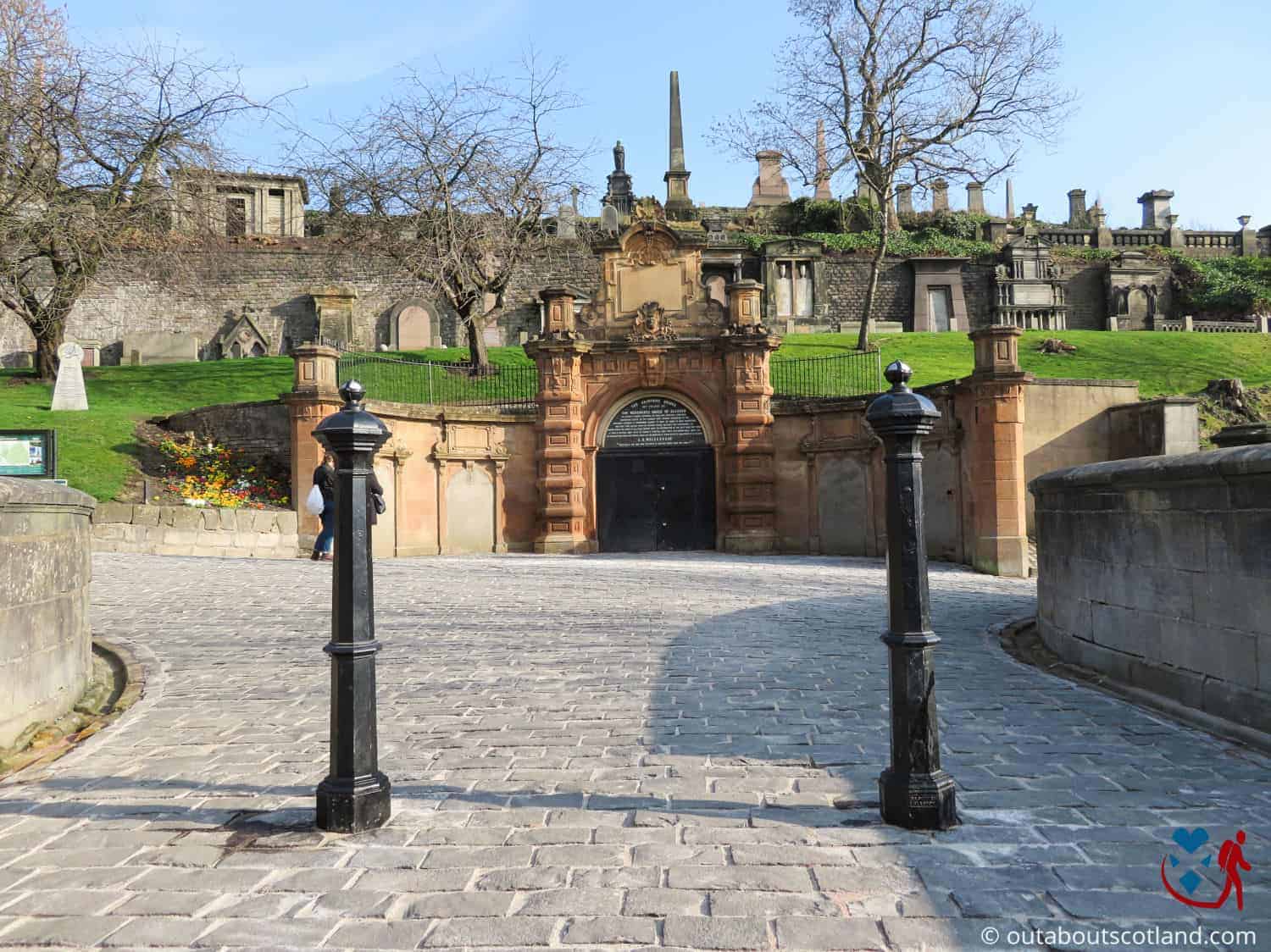
Out About Scotland Guide: Glasgow Necropolis
| Address: | Wishart Street, Glasgow, G4 0UZ |
| Opening Hours: | 24/7 |
| Admission Price: | Free |
| Parking: | Paid car park on Castle Street |
| Contact: | To book a tour - tours@glasgownecropolis.org |
| Facilities: | None |
| Photos: | Virtual Tour YouTube Video |
Visiting the 37-acre Necropolis, located next to the cathedral, is arguably one of the most unique things to do in Glasgow and is a great option for anyone seeking out-of-the-ordinary things to do near the city centre.
Over 50,000 Glaswegians are buried in this Victorian cemetery, and a visit will reveal numerous monuments honouring Scottish notables from John Knox (the founder of the Scottish Presbyterian Church) to Charles Rennie Mackintosh (Scotland’s most influential architect).
Glasgow’s Necropolis, like other Victorian burial places, is set out like an informal park, with winding paths threading their way through a huge collection of gravestones that are evocative of the similarly massive Pere Lachaise Cemetery in Paris.
There are around 3,500 tombs in this ‘city of the dead,’ the most noteworthy of which is the John Knox monument located at the cemetery’s highest point. Seeing the cathedral and Glasgow’s sprawling streets from this viewpoint is a real highlight, but the best part of visiting the Necropolis is getting lost in the maze of pathways that cover it like a gigantic spiderweb.
To truly grasp the history of the cemetery you can take a guided tour when you visit, but arguably the best way to explore it is to wander about it at your own speed, which you can do until late evening.
If you do visit at nightfall, you may be fortunate enough to see pipistrelle bats darting about as well as roe deer, wood mice, and voles.
Protect Your Family From Scotland's Biting Midges
- Powerful, reliable protection for up to 8 hours
- Water- and sweat resistant
- Repels midges, mosquitoes, horse flies, sand flies, fleas and ticks
- Safe for use on adults, children over 30 months and pregnant women
- Non-sticky, moisturising with a pleasant fragrance
- Packaging may vary
The Tall Ship
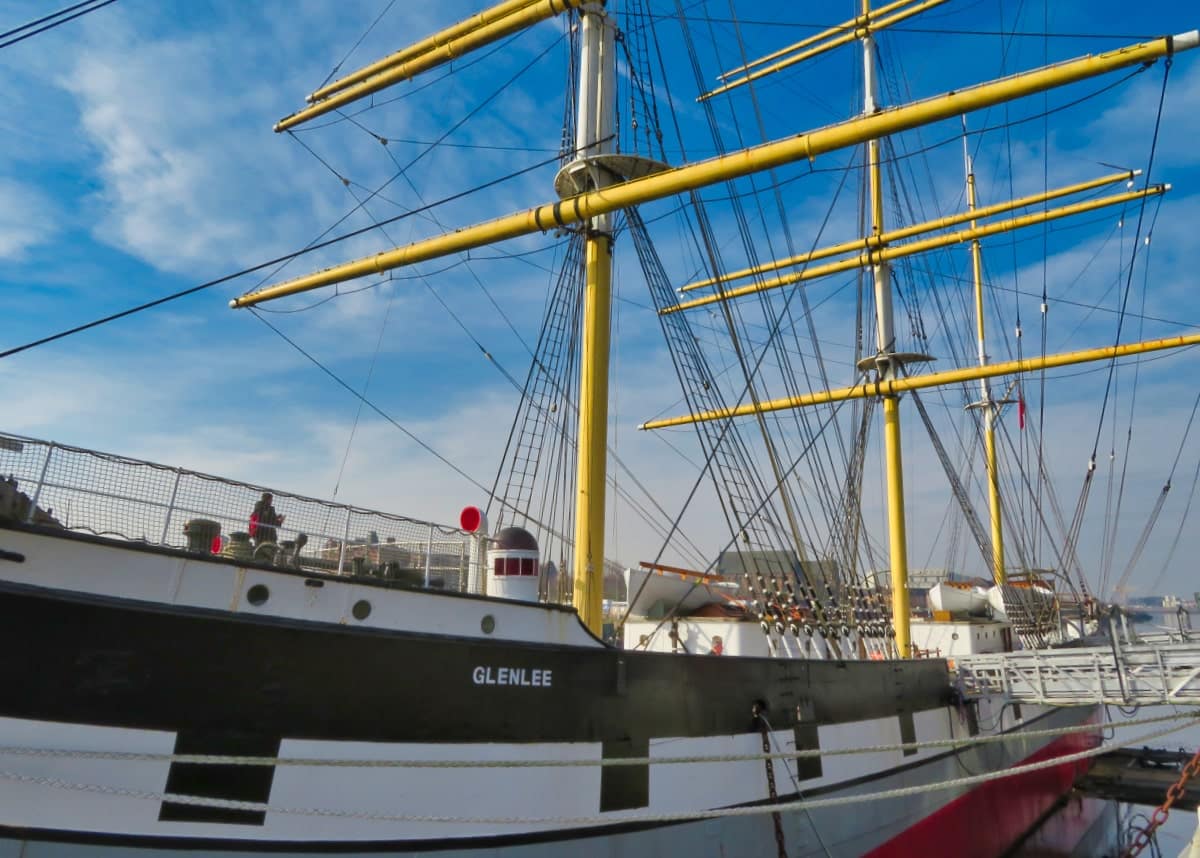
Out About Scotland Guide: The Tall Ship
| Address: | 150 Pointhouse Place, Glasgow, G3 8RS |
| Opening Hours: | Monday 10am - 5pm Tuesday 11am - 5pm Wednesday 10am - 5pm Thursday 10am - 5pm Friday 10am - 5pm Saturday 10am - 3pm Sunday 10am - 5pm |
| Admission Price: | Free |
| Parking: | Paid car park at the Riverside Museum |
| Contact: | 0141 357 3699 |
| Facilities: | Cafe, shop, toilets, disabled access, baby changing |
| Photos: | YouTube Video |
The Tall Ship is a restored sailing ship from the 1800s. It’s docked at Pointhouse Quay on the Clyde and is one of Glasgow’s most popular tourist attractions. The Tall Ship (officially titled ‘Glenlee’) is one of only five remaining tall ships constructed on the Clyde and is a must-see for anybody interested in Glasgow’s maritime heritage.
During a tour, visitors can listen to an audio commentary that provides insight into what life was like for the crew of a British sailing ship over a century ago, including information on what they ate and where they sailed.
With so much to see and do, such as piloting the ship from the helm, seeing the captain’s quarters, watching a movie in the onboard theatre, and exploring the cargo hold, it’s difficult to imagine anybody being bored at this attraction.
Self-guided tours start at the gangway where visitors can explore the upper deck, see into the main deckhouse, and take in an amazing view of the ship’s masts and their intricate web of ropes and pulleys.
As you make your way down from the bridge to the tween deck you’ll get your first real sense of just how massive the ship really is. On one side of the tween deck is a well-stocked gift shop, and they’ve also managed to squeeze in a full-size café—all while using less than half of the deck’s square footage.
The toilets and a teaching room are located on the lower deck, along with exhibits about the kinds of goods the ship would have carried. And of course, the Riverside Museum of Transport is located next door, so you can attend both attractions in a single day, which you’ll no doubt want to do considering they’re both entirely free to visit.
Kelvingrove Park

Out About Scotland Guide: Kelvingrove Park
| Address: | Kelvingrove Park, Kelvin Way, Glasgow, G3 6BY |
| Opening Hours: | 24/7 |
| Admission Price: | Free |
| Parking: | No on-site car park. Kelvingrove SPT car park nearby. |
| Contact: | 0141 334 6363 |
| Facilities: | Toilets, play areas, sports pitches, cafes, skateboard park, disabled access |
| Photos: | YouTube Video |
Created in 1852 for the city’s middle class, this park is a picturesque green oasis filled with monuments from the past as well as modern sports facilities.
The wide paths and tree groves make it perfect for a leisurely stroll, while the River Kelvin provides a peaceful respite from the city’s hustle and bustle. Along the riverbanks, there’s a good chance you’ll even see geese, kingfishers, herons, and otters – not what you’d usually expect from a walk in a busy city.
One of the best ways to experience Glasgow is by walking the entire length of the Kelvin Walkway, a 10-mile footpath that takes you from Kelvingrove Park to the peaceful Milngavie countryside. The walkway starts near Kelvingrove Art Gallery and Museum on the southwest edge of the park and continues northward, providing a good opportunity to check out the park’s many monuments along the way.
Kelvingrove Park’s main attraction is the Stewart Memorial Fountain. It was created in 1872 to celebrate the freshwater transit connection from Loch Katrine to Glasgow, and is today enjoyed as a place to unwind on a warm day owing to the manicured lawns and beautiful flower beds that surround it.
Other monuments include the Lord Frederick Roberts Memorial and the historic bandstand which hosts a variety of music festivals, and charity shows throughout the year. The park also features three children’s play areas and a variety of cafes, including the family-friendly An Clachan, located near the park’s eastern entrance.
Stop Painful Blisters Spoiling Your Time In Scotland
- Deep cushioning to relieve pressure and prevent painful rubbing
- Hydrocolloid active gel technology creates an optimal healing environment for foot blisters
- Adhesive, tapered edges so Compeed flexes with movement and won't rub off
- Keeps natural moisture in and germs out, with translucent edges to help blend in with the skin
- It prevent, ease the pain, and make a recovery faster
Getting Around Glasgow
Taxi: Taking a taxi is by far the quickest way to get around Glasgow and the official Glasgow Taxis operate throughout the city with their distinctive black cabs making them easy to distinguish from the private mini-cabs that also run in the city centre. They offer 5- and 6-seater vehicles, and if their yellow light is on, they can be flagged down on the street. Alternatively, telephone 0141 4297070 to book one in advance.
Bus: The main bus operator in Glasgow is First Bus, which provides regular bus services throughout the city with over 100 routes to choose from. Most locals prefer to use the bus network, as it’s one of the easiest and cheapest options for getting around the city centre and the outlying districts.
Frequently Asked Questions
What are the best things to do in Glasgow City Centre?
Popular things to do in Glasgow city centre include visiting Kelvingrove Art Gallery and Museum, touring Glasgow Cathedral, and exploring the Riverside Museum. The Gallery of Modern Art (GoMA) is also a popular attraction, as is the People’s Palace which is a great place to learn about the city’s history and culture.
Is 1 day enough for Glasgow?
One day may be enough to see some of the main attractions in Glasgow, but it would likely be a very busy and rushed day. Some of the biggest attractions such as Kelvingrove Art Gallery and Museum can take a full afternoon to fully explore.
If you’re looking to make the most of your time in Glasgow, it would be best to plan your itinerary in advance and focus on the most important attractions. Alternatively, you could consider spending two or three days in Glasgow which would allow you to see most of the city at a leisurely pace.
What are the most popular things to do in Glasgow with children?
There are many fun and educational things to do in Glasgow with children. Some popular options include:
1: Kelvingrove Art Gallery and Museum – This museum features a wide variety of exhibits including art, natural history, and science.
2: Glasgow Science Centre – This interactive science museum features hands-on exhibits and live science shows.
3: Riverside Museum – This museum is dedicated to Glasgow’s transport history and features displays of cars, trains, and ships.
4: Glasgow Botanic Gardens – These gardens feature a wide variety of plants and flowers and a children’s playground.
5: Glasgow Climbing Centre – Children will love climbing and exploring this indoor climbing centre which has a dedicated kids area.
Where is Glasgow?
Glasgow is located in the western lowlands of Scotland at roughly the same latitude as Edinburgh. It’s a port city and is famous for its shipbuilding industry centred around the River Clyde.
Distances from other UK cities:
Glasgow to Edinburgh: 39 miles (62.76 km).
Glasgow to London: 346 miles (556.83 km).
Glasgow to Birmingham: 253 miles (407.16 km).
Glasgow to Manchester: 184 miles (296.12 km).
Glasgow to Cardiff: 306 miles (492.46 km).
Protect Your Family From Scotland's Biting Midges
- Powerful, reliable protection for up to 8 hours
- Water- and sweat resistant
- Repels midges, mosquitoes, horse flies, sand flies, fleas and ticks
- Safe for use on adults, children over 30 months and pregnant women
- Non-sticky, moisturising with a pleasant fragrance
- Packaging may vary





